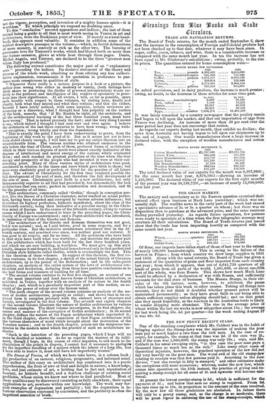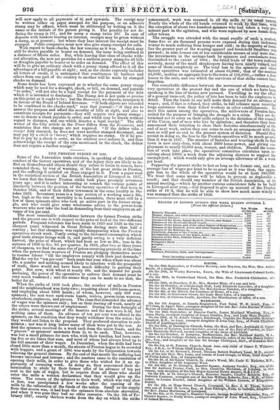THE NEW PENNY RECEIPT STAMP.
One of the standing complaints which Mr. Cobbett was in the habit of bringing against the Stamp-laws was the injustice of making the poor man pay so much higher a rate than the rich man. In the case of re- ceipts, for example, the stamp at that time was 2d. if the sum was 2/, and if the sum was 1,000,0001. the stamp was only 108.; ergo, said Mr. Cobbett in his usual sweeping style, "in this case the poor man pays a thousand times as much tax as the rich.” Like many other cases of theoretical injustice, however, the practical operation of the law did not fall very heavily on the poor man. The worst evil of the old stamp-law relating to receipts was that few persons paid it. According to the Lam Besiew, "not one receipt in fifty is stamped," and other estimates make the exceptions still more numerous ; whereas, under the new law, which comes into operation on the 10th instant, the practice of giving and re- quiring a stamp-receipt for all sums of 21. and upwards will become tune versa. At present the lowest receipt-stamp is 3d., which is sufficient for the payment of 51.; and below that sum no stamp is required. From 8d. the rate rises up to 10s. in proportion to the amount ot the sum received. By the new law all these gradations are abolished. In future there will only be a penny stamp, and, as the charge is so moderate, there will be great rigour in enforcing the use of the stamp-receipts, which will now apply to all payments of 24 and upwards. The receipt may be written either on paper stamped for the purpose, or an adhesive stamp may be affixed, which must be obliterated by writing on it the name or the initials of the person giving it. The penalty for not de- facing the stamp is 101., and for using a stamp twice 201. In case of deposits with bankers bearing no interest, receipts may be given without a stamp, as at present ; but where they bear interest the receipt must be stamped. Public companies must now also give stamp-receipts for calls.
With regard to bank-checks, the law remains as it was. A check may still be drawn payable to bearer on demand, the issue being confined to a distance of fifteen miles. But, while leaving that class of checks with- out alteration, the new act provides for a uniform penny stamp for all bills or draughts payable to bearer or to order on demand. The effect of this will be to give an ordinary check with a penny stamp affixed to it all the advantages of a bill payable at sight ; and, as the clause expressly includes all letters of credit., it is anticipated that remittances by bankers and others from one part of the country to another will be made by stamped checks on demand.
Some doubt has been expressed as to whether the same penny stamp which may be used for a draught, check, or bill, on demand, and payable "to order,', will not also be a legal receipt for the payment of the debt which it is intended to discharge. The Stamp Act is not quite so precise on this point as it ought to be ; but the Economist, we observe, interprets it in favour of the Board of Inland Revenue. "If both objects are intended to be combined in the cheeks used," says that journal—" if they are to answer the purpose and afford the security of bills at sight, and also to constitute receipts for payments—they will require two penny stamps ; one to denote a check payable to order, and which may be drawn without regard to distance, and one -which denotes a legal receipt." The able writer of the City article in the Times differs from the Economist, and maintains that two stamps are not required. "If the debtor take a receipt duly stamped, he does not want another stamped document, and may pay by a check to 'bearer,' which requires no stamp. Or if he pre- fers to pay by a check to order, as the creditor must indorse it, and thus acknowledge the receipt of the sum mentioned in the check, the debtor does not require a further receipt."



























 Previous page
Previous page